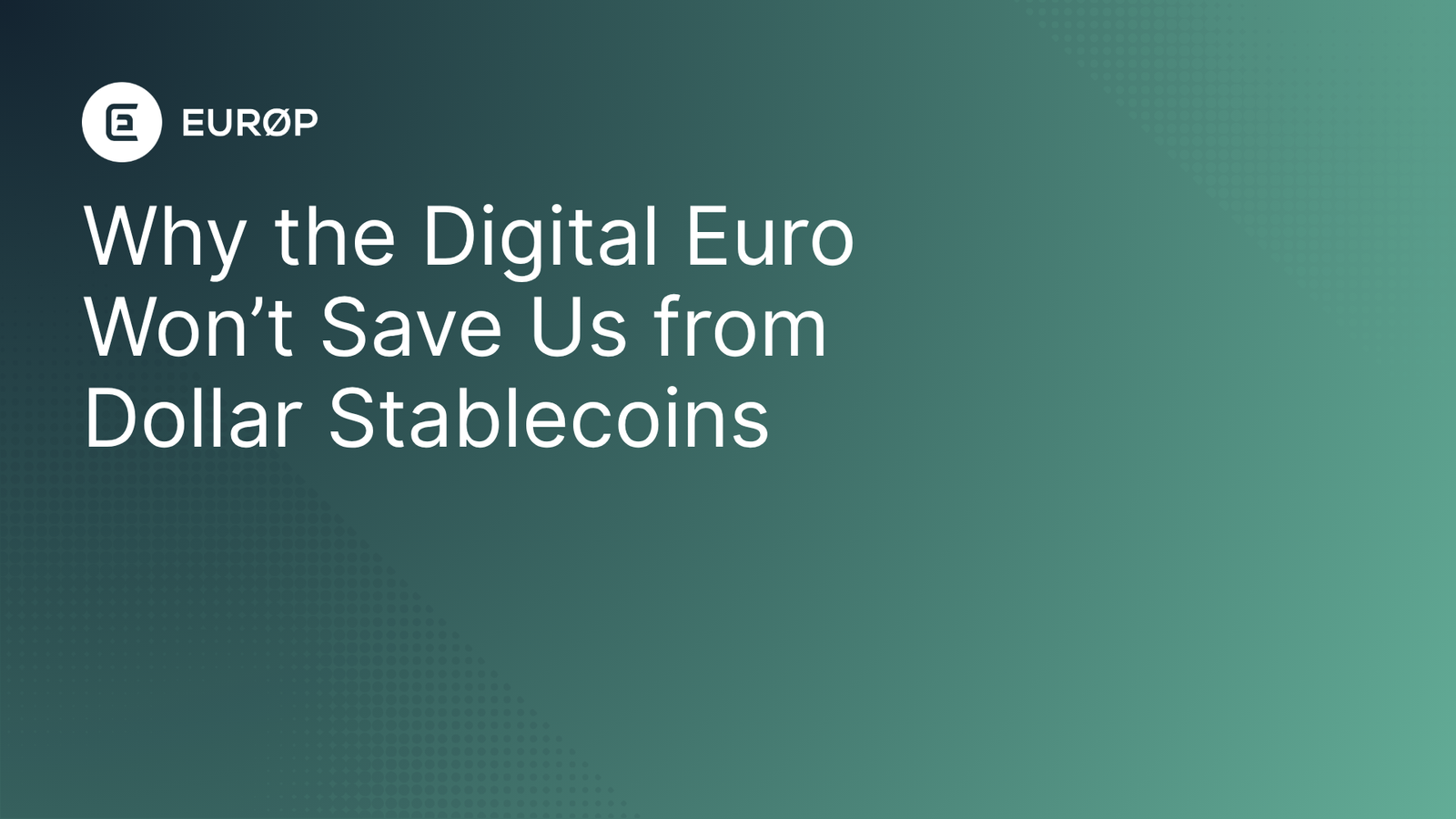Why the Digital Euro
Won’t Save Us from Dollar Stablecoins
Stablecoins are well on their way to rewriting global finance. Yet the European Central Bank (ECB) appears intent on repeating past missteps by resisting this emerging disruption. Rather than fostering European stablecoins, the ECB wants to fight them with an unproven, government-run alternative: the digital euro.
Stablecoins are no longer a niche phenomenon—they are fast becoming mainstream. In a recent survey, 90% of financial institutions reported that they are actively engaging with stablecoins. Banks, asset managers and payments giants such as Visa and PayPal are already incorporating them into their operations. However, out of the approximately $230 billion in stablecoins currently in circulation, more than 99% are pegged to the dollar. This could pose a significant challenge to Europe’s monetary sovereignty. If dollar-backed stablecoins were to gain a substantial foothold in Europe, the continent would risk even greater dependence on US payment providers and diminished control over its monetary system.
Nonetheless, the ECB exaggerates the dangers posed by dollar stablecoins and underestimates the transformative role that euro-denominated stablecoins could play in revitalising Europe’s payments infrastructure and strengthening the international role of the euro.
Payments in Europe are never going to become meaningfully dollarized through stablecoins. MiCA stipulates that stablecoins offered in the EU must be issued by licensed European entities and gives regulators sweeping powers to stop the operations of any issuers whose stablecoin they deem to pose a threat to EU’s financial stability. In addition, MiCA places strict limits on non-euro stablecoins—any that exceed €200 million in daily transactions in the EU could be banned. Given that eurozone banks process approximately €1.6 trillion in daily fiat transactions, the prospect of payments in Europe becoming meaningfully dollarised through stablecoins remains remote.
The ECB’s response to dollar stablecoins, however, is to push ahead with its own digital euro project. This strategy assumes that a state-backed digital currency will be inherently more attractive to financial institutions and consumers than privately issued stablecoins. But this logic is flawed. The success of platform technologies such as stablecoins depends less on the technology itself and more on the network of applications and partnerships that grow around them—ecosystems typically driven by private entrepreneurs and developers.
Stablecoins did not become mainstream on their own. Their issuers have spent years adding features, creating infrastructure and forging partnerships to drive adoption. Financial institutions have responded by investing heavily in blockchain-based infrastructure and services built around stablecoins. Euro stablecoins could integrate seamlessly with these emerging networks, offering an efficient and attractive alternative to dollar stablecoins. In contrast, the digital euro would require significant additional investment and effort by private actors, making it a far less compelling proposition.
Europe’s own recent experience with public-private tech initiatives, such as GAIA-X, illustrates the challenge. Launched in 2019 to provide a European alternative to US cloud providers, GAIA-X has yet to produce a viable competitor to Amazon Web Services, despite substantial public funding. This cautionary tale suggests that while governments can play an important role in infrastructure, they are rarely best placed to compete directly with the private sector in the adoption of new technologies.
Furthermore, the stablecoin ecosystem has a direct link to government financing. Private stablecoin issuers invest their reserves in short-term government debt. With total stablecoin issuance projected to reach $2 trillion within five years, these issuers could soon become some of the largest buyers of sovereign bonds. Already today, when a dollar stablecoin is used for payments in Africa, its African users are effectively bankrolling Uncle Sam. Indeed, Tether, the British Virgin Islands-based issuer of USDT was the seventh-largest foreign net buyer of US Treasuries last year, making it as important as all UK-based investors combined. This growing demand for sovereign debt can help lower borrowing costs, which would be particularly beneficial for heavily indebted European governments. In contrast, as an unbacked liability of the ECB, the digital euro offers no comparable benefit.
Despite Europe’s current lag in stablecoin adoption, it is not without advantages. European fintech firms and crypto projects have shown they can successfully compete with their American counterparts, while Europe remains the world’s largest crypto economy by transaction volume. The US Treasury Secretary Scott Besset recently declared, “We are going to keep the U.S. [dollar] the dominant reserve currency in the world, and we will use stablecoins to do that.” In response, European policy makers would do well to nurture Europe’s own stablecoin ecosystem rather than relying solely on a central bank-issued digital euro. If it wants to keep its strategic autonomy in finace, let alone grow the global importance of the euro, Europe needs to have at least one systemically important euro. As such, the European leaders may want to begin by reforming the existing stablecoin regulatory framework. Paradoxically, it currently puts such onerous and illogical restrictions on issuers of systemically important euro stablecoins, that it renders large euro stablecoins unviable.
The author is Martin Bruncko, CEO and Founder of Schuman Financial and a former innovation minister and deputy finance minister of Slovakia.



